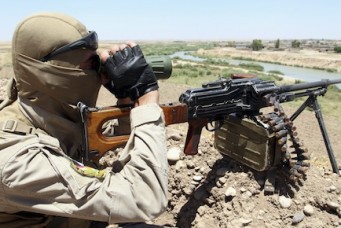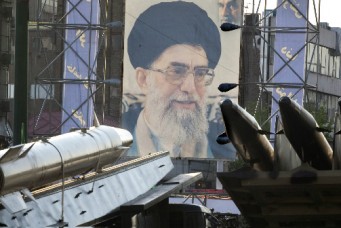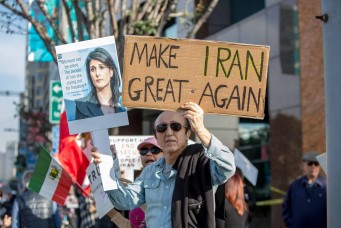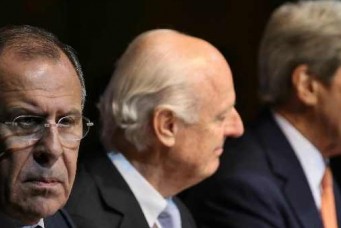U.S. and Iran: Overcoming a Hard Legacy
With the announcement of a nuclear deal in Vienna, a three-decade freeze in relations between the U.S. and Iran is beginning to break. A former American diplomat with a deep knowledge of Iran explains the way forward.
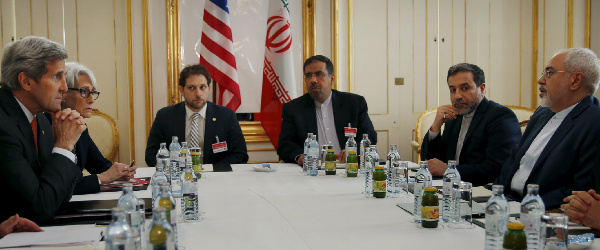
U.S. Secretary of State Kerry meets with Iran’s Foreign Minister Zarif in Vienna, Austria, June 28, 2015. Carlos Barria/Reuters/Corbis
During the first year of Barack Obama’s presidency, in response to Iranian feelers about opening discussions, the United States decided that there could be no bilateral dialogue with Iran—about cooperating to stem the flow of drugs from Afghanistan, for example—before resolution of issues around Tehran’s nuclear program. Following Hassan Rouhani’s election as president in 2013, the Iranian side took a similar position, saying that priority would go to nuclear issues and that discussion of other matters must await an agreement between Iran and the permanent members of the United Nations Security Council plus Germany (P5+1).
For better or worse, the United States and Iran decided to put their bilateral eggs into a very difficult (nuclear) basket. Rather than look at issues where interests could push the two sides toward shared benefit, they made their relationship dependent on finding agreement on a complex issue loaded with technical problems and political symbolism. Now that the Islamic Republic and the P5+1 group have reached a historic agreement in Vienna—restricting Iran’s nuclear program in exchange for sanctions relief—can the two countries begin the dialogue they should have started decades ago? If they can, how should they talk, and what should they talk about? The whole relationship remains fragile, and could still wreck itself on the mutual obliviousness, missteps, miscalculations, bad timing, and bad luck that have a way of sabotaging U.S.-Iranian openings.
One of the perverse effects of the long Iranian-American estrangement has been the two sides’ inability to talk about issues that concern both, even when such talks would benefit both. In a reasonable world, American and Iranian officials would have begun talking decades ago about such issues—not as friends but as states with interests. Even after 2009, when President Obama announced his desire for a “new beginning” with Iran based on mutual interests and mutual respect, starting a dialogue proved very difficult.
Why has talking been so hard? I would suggest the following:
—A legacy of mutual mistrust. Each side remains deeply suspicious of the other, and the prevailing attitude is that the other side is devious by nature (“deception is part of the [Iranians’] DNA,” according to one senior American official) and that there is always a hidden and nefarious purpose behind even the seemingly innocuous actions and statements of the other side.
—Fear of the unknown. After more than thirty years of trading insults, threats, and accusations, neither side was capable of doing anything else. Although such exchanges produced no benefit, both sides at least knew how to do them. What they could not do was change the relationship into something more productive. Doing so would have meant venturing into unfamiliar territory.
—Personalities. President Obama’s first term as president coincided with much of President Mahmoud Ahmadinejad’s second term. The latter, thanks to his dubious reelection in 2009 and his thoughtless rhetoric, had become part of the problem between the two countries. By 2010, anything—reasonable or unreasonable—associated with Ahmadinejad had become poisonous in Washington. People simply stopped listening.
—Domestic politics. The Islamic Republic was born and shaped in an atmosphere of virulent anti-Americanism and its survival has depended on keeping the political pot boiling with wars, crises, and turmoil. Although Iran’s issues are not central to domestic U.S. political dialogue, among certain groups they evoke a powerful negative response. When necessary, Iran’s past misdeeds and Ahmadinejad’s provocative rhetoric will reinforce the Islamic Republic’s image as a center of terrorism, violence, religious bigotry, and oppression. Anyone advocating changing Washington’s confrontational approach is called naïve, delusional, and worse.
As the United States and Iran explore areas of cooperation and talk about issues such as Afghanistan, narcotics trafficking, the environment, and public health, they also need to deal with the base legacy issue: trust and mistrust. If we disregard this issue, the “ghosts of history” will haunt the effort and cripple efforts to change how the parties deal with each other. In 2012, for example, when sailors from the American destroyer USS Kidd rescued Iranian fishermen from Somali pirates in the Arabian Sea, the Iranian government’s public response was both incoherent and ungracious. In the prevailing toxic atmosphere, a simple “thank you” was apparently more than the system could bear.
As long as we ignore the ghosts, the whole process will remain fragile, and any ill-considered statement or action will send the two sides back into the futile arena of hostility. We cannot undo the damaging acts and statements of the past decades; but we can at least recognize them and limit the harm they do.
The parties must take constructive steps. The Islamic Republic needs to renounce and distance itself from the U.S. embassy hostage taking of 1979–81. Possible measures include:
—Quietly removing former hostage takers from key roles in the administration.
—Ending or limiting the annual demonstrations commemorating the events of November 4, 1979. (President Mohammad Khatami did so during his time in office.)
—Making some gesture toward the former American hostages or their families.
—Ensuring security for future visiting or resident American officials.
The Islamic Republic should cooperate with investigations into acts of terrorism in Germany, Argentina, Washington, and elsewhere that allegedly involved Iranian agents. Tehran should return Dawud Salahuddin, the alleged assassin of Iranian dissident Ali Akbar Tabatabai in Maryland in 1980, to American officials.
The Islamic Republic should ease conditions of those American (and dual-national) citizens it has detained without due process or trial. The Islamic Republic should cooperate with American authorities to determine the whereabouts and status of former FBI employee Robert Levinson, who disappeared in Iran in 2007.
The American government should clarify and demonstrate that it is not in the regime change or overthrow business. Attitudes and suspicions will not change quickly, but practical steps include:
—Limiting the U.S. activities of the Iranian opposition group Mujahedeen-e Khalq (MEK), including its payments to former officials to speak and lobby on behalf of the group.
—Ending any activity that would suggest the United States is supporting Iranian ethnic or regional separatist movements.
—Denouncing acts of terrorism that target Iran.
—Controlling language. President Obama’s 2009 statement, for example, that he was speaking to “the people and leaders of the Islamic Republic of Iran,” had a significant impact and signaled a major, if symbolic, change of U.S. policy.
The American government should, like the Iranian side, acknowledge the uglier aspects of its past policies and actions: the 1953 coup d’état against Prime Minister Mohammad Mosaddegh; the shooting down of Iran Air 655 by the Aegis cruiser USS Vincennes in 1988; and support both overt and covert for the Iraqis during the Iran-Iraq war. If possible, for example, it would be helpful to withdraw or downgrade quietly the medal given to the captain of the USS Vincennes.
Old grievances should not be left to fester, but should be aired via “truth and reconciliation” mechanisms, such as scholarly conferences, neutral investigations, and meetings of retired former rivals. If his health permits, former President Jimmy Carter should visit Iran (just as former President Khatami has visited the United States).
Both sides should also acknowledge the positives in the relationship: the contribution of Iranian-Americans to U.S. science, culture, and the economy; the American scholars who have taught Persian language and history to American students; American support for Iran’s struggle for pride and independence, including the Constitutional Revolution of 1905–11 and the Azerbaijan crisis of 1945–46; and American mediation during the oil nationalization dispute of 1951–53.
For effective talks, it is important to get the basics right. These principles should help us keep our footing on the uncertain ground we will have to traverse:
—Move carefully. Pay homage to the “ghosts in the room” that haunt the relationship. Avoid overreach. Grand gestures will be misread and seen as threatening.
—Respect the power of symbolism. Handshakes, telephone calls, civil encounters, all carry enormous symbolic value, whatever the substance.
—Respect the importance of words and concepts. For the Iranian side, concepts of “justice,” “rights,” “mutual respect”—for historical and religious reasons—carry enormous importance. Avoid condescending phrases such as “you might not understand…” and “change their behavior,” which belie professions of mutual respect.
—Keep as much as possible out of the public realm and the media. Public exchanges encourage the most extreme positions involving phrases like “not one inch” and “never.”
The two sides should create channels and mechanisms beginning with the assumption that if they talk instead of shouting at each other, the sky will not fall. In creating channels for dialogue, both sides should work quietly and avoid the message that anyone is doing anyone a favor.
The U.S. should end its “no-contact” policy with Iranian officials, a relic of the era when Americans and “Chicoms” avoided each other. American and Iranian representatives everywhere should be able to talk.
There should be regular dialogue at the highest-possible level that allows for private discussions. There should also be regular meetings of experts.
The United States and Iran should send official delegations to participate in conferences in each other’s country.
Washington should ease travel restrictions on members of Iran’s United Nations mission in New York.
In conducting political dialogue, both sides must overcome the fear that “if we propose X or say yes to Y, we’ll look weak.” As in any relationship, the two sides should recognize that some interests clash and others coincide. Where they clash, the emphasis should be on avoiding violence and recognizing that the other side is not going to change its policies simply because “we” wish it to. In this area, for example, it would be useful to establish a diplomatic and military hotline between the two capitals, and create mechanisms for avoiding incidents at sea or in the air in the Persian Gulf and the Gulf of Oman. Doing so will require a new level of professionalism from Iranian Revolutionary Guard Corps naval units.
Where interests coincide, the parties should explore the possibilities for joint action. Iran and the United States cooperated effectively during the 2001–02 talks on Afghanistan, but that cooperation vanished in the wake of President George W. Bush’s 2002 “Axis of Evil” speech. The United States needs to recognize that Iran can be part of solutions to crises in Iraq, Afghanistan, and Syria. Although interests may not be identical, there are enough shared goals—such as countering extremist groups like the Taliban and Islamic State in Iraq and Syria, and preventing the splintering of Iraq and Syria—to justify regular consultation between military and civilian officials.
In the past, the Iranian side has deflected requests for consultations by suggesting they be held in Tehran. Washington should now be ready to call the Iranians on these suggestions, and explore where the process leads.
Some ideas about the agenda for talks:
—Technical Assistance. Make the rain fall up. There needs to be mutual benefit. Rather than duplicate the old pattern of “the U.S. gives and Iran receives,” we should seek those areas in which Americans can benefit from particular Iranian expertise. An example is the Mississippi Delta medical project, which has profited from the experience of Iran’s khaneh-ye-behdasht (rural health house) project to deliver primary health care to one of America’s poorest regions. Another possibility is that American medical professionals could benefit from Iranian expertise in treating victims of poison gas, an area in which the U.S. side has little experience.
—Exchanges. There is likely to be a huge demand for Iranians to study in the United States in engineering, health, petroleum, computers, and so on. Barriers such as a visa and security clearance systems from hell and financial restrictions should come down. The United States should no longer treat Iranian grandmothers as security threats. Americans should be able to teach, and pursue studies and research in Iran.
We should speed up the pace and numbers of exchanges of educators, writers, artists, journalists, filmmakers, athletes, musicians, religious leaders, and scholars. The United States should reopen the American Institute for Iranian Studies in Tehran. America should explore ways of restarting the Fulbright program both for teaching and research.
The United States should institute exchanges outside of the federal executive branch by sending bipartisan delegations from Congress and from state and local governments.
—Representation and Properties. As part of the official dialogue, both sides should upgrade their representation in the other’s capital. American and Iranian diplomatic personnel should staff existing interest sections in Tehran and Washington respectively.
Beyond issues of representation, the two sides should address the question of diplomatic properties. Both hold valuable assets in Washington and Tehran. If the United States ever does open an office in Tehran, there may be too many evil spirits in the old embassy buildings. A new relationship needs an exorcism, or better, a new start in a place free of bad memories.
—Petroleum. By all accounts, Iran’s petroleum industry is aging and in need of investment. Investment plans were shelved after the revolution and the oil income, with minimum investment, went to immediate needs of food and munitions. U.S. firms and U.S. technology have a major opportunity to participate in modernizing Iran’s oil industry if Iran makes the necessary investment decisions.
Easing restrictions would also open possibilities for energy cooperation with Persian Gulf neighbors and with U.S. firms’ participation, such as reviving the Sirri-Dubai gas project that was stopped by U.S. congressional action in 1994.
—Civil Aviation. A settlement would open possibilities for Iran to modernize its aging fleet of Boeing civil aircraft and to buy replacement parts for its Airbuses. This area could prove difficult, however, if Iran uses civilian aircraft to reinforce its allies in Syria and Lebanon.
—Terrorism. A difficult issue. In this area, the best we may get is to “agree to disagree.” No one is going to admit wrongdoing. Each side will claim that it has been the victim of terrorism and will hint that the other side was responsible in some way. We should not let exchanges descend into public confrontation and trading accusations. Perhaps the best way of dealing with the issue in the near term is to create neutral “commissions” to look into complaints. The tone of communications will be crucial here, as we saw in the fiasco of the accusatory letter President Bill Clinton sent to Khatami in 1999—inviting better relations while accusing the Iranians of a terrorist strike on Americans in Saudi Arabia.
—Finishing the Hague Tribunal. The Hague tribunal, set up in the wake of the Algiers Accords of 1981, should finish its work. Thirty-four years is more than enough time. Most of the remaining cases reportedly involve cancelled U.S. military sales and military materiel paid for but never delivered to Iran. While Iran is not going to get the original military equipment it ordered, there should be a settlement that delivers either the blocked funds or some civilian equipment of equal value.
Good nuclear deal or bad nuclear deal, in the last two years the United States and Iran have traveled far beyond their long and futile impasse. A three-decade freeze in relations is beginning to break. Rather than trade insults, accusations, and threats, American and Iranian officials now hold meetings they describe as “productive” and “positive,” adjectives unheard for thirty-six years. The sources of mistrust and dislike remain and will be overcome only with patience and forbearance on both sides. The unfortunate history of the last fifty years cannot be undone. But it can be acknowledged and balanced against current interests that outweigh the need to repeat endlessly empty slogans and lists of grievances both real and imagined.
A version of this article originally appeared on July 14, 2015.
John Limbert is the Class of 1955 Professor of Middle Eastern Studies at the United States Naval Academy in Annapolis, Maryland. During a thirty-four-year career in the U.S. Foreign Service, he served as deputy assistant secretary of state for Iran from 2009 to 2010, and as ambassador to Mauritania between 2000 and 2003. From 1979 to 1981, Limbert was among fifty-two Americans held hostage after the seizure of the U.S embassy in Tehran. He is the author of Iran: At War with History, Shiraz in the Age of Hafez, and Negotiating with Iran: Wrestling the Ghosts of History.
Subscribe to Our Newsletter

